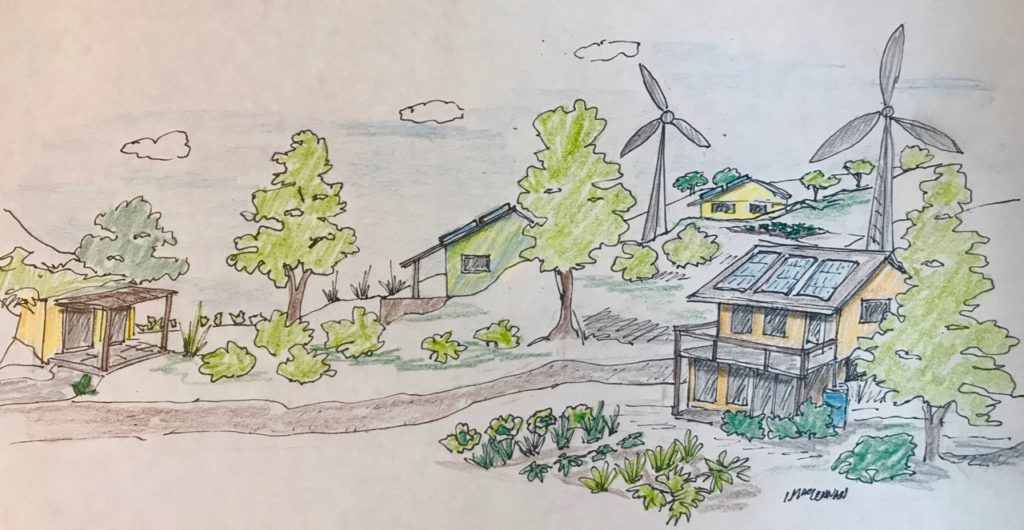
Given the challenges we face today regarding the lack of affordable housing and the vulnerability of infrastructure to intense weather events, these difficulties will only be magnified thirty years from now. It was clear that innovative, less costly building designs and construction materials were needed in order to provide homes and services for the refugees fleeing from the rising ocean levels and other impacts in ways that were both sustainable and more resistant to flooding and fires.
In order to accommodate the population increase, people adjusted to smaller living spaces, while enjoying more time spent outside and in community spaces. Many of the mega-homes have been converted to multi-family or group homes, with carriage houses in backyards and front yard lawns replaced by vegetable gardens. Solar powered heat pumps provide heating and cooling, along with geothermal systems.
New home construction utilizes hemp products such as hempcrete blocks, hemp wallboards and hemp insulation, as well as steel from recycled cars and truck frames. Conventional concrete has been mostly replaced by earth-friendly concrete that is made with a technique that releases far less carbon dioxide. For above ground construction, straw bales and rammed earth reduce construction expenses and provide more warmth in the winter and cooling in the summer.
Co-operative group housing is very popular, as there are lower costs and more social benefits when people share living arrangements, along with transportation. Working spaces are often combined with living spaces to minimize commuting time and costs.
When the demand for living spaces outstripped the supply, new designs for housing developments were created that allowed for greater self-sufficiency. New small communities were developed on crown land with off-the-grid homes that utilized water recycling systems, composting toilets, geo-thermal heating and cooling.
Many new homes are built into hillsides with the first floor mostly underground, which provides many benefits including providing a place to avoid the heat during the summers and to take advantage of natural warmth of the earth in the winter. These houses are designed to be upside-down, with the bedrooms below and the kitchen and living area on the second floor.
The population of Shuswap communities increased exponentially due to migration from coastal areas and southern countries that became uninhabitable due to rising temperatures and harsh weather. To meet the demand for housing, urban planning focused on providing higher density and well-spaced commercial areas, so shoppers do not have to travel far to get the goods they need.
Streets are narrower and lined with shade trees. Vehicles are smaller, fewer in number and have hemp-plastic bodies and hemp-lithium batteries that last longer and hold a charge longer than the original batteries developed four decades earlier. Most people use bikes and scooters for local transportation, while the electric cars and trucks are often shared amongst a number of families.
Infrastructure, services and communities are designed around the principle of minimalism and decentralization, to reduce carbon emissions by ensuring that most needs are met within short distances. As well, all new buildings are built to withstand the rising temperatures and extreme weather events and existing structures were renovated to achieve the same goals.
Thanks to innovative engineering, wastes have largely been eliminated with recycled goods remanufactured locally and many products are designed for re-use. Any single use containers still in use are composted and then used as soil additives.
Despite the warmer and more unpredictable climate and the much larger population, life in the Shuswap has improved thanks to greater cooperation, along with structures and lifestyles that are more in tune with the natural world.
POSTSCRIPT
Successful climate change adaptation in communities includes reducing use of electricity, water, goods and travel by automobiles. Protection from intense weather events is key with buildings and infrastructure designed to handle heavy rains, strong winds and intense heat. Some new highways are built with imbedded solar panels and some are paved with recycled plastic rather than asphalt. New technology is developed to improve quality of life while minimizing use of non-renewable resources.






